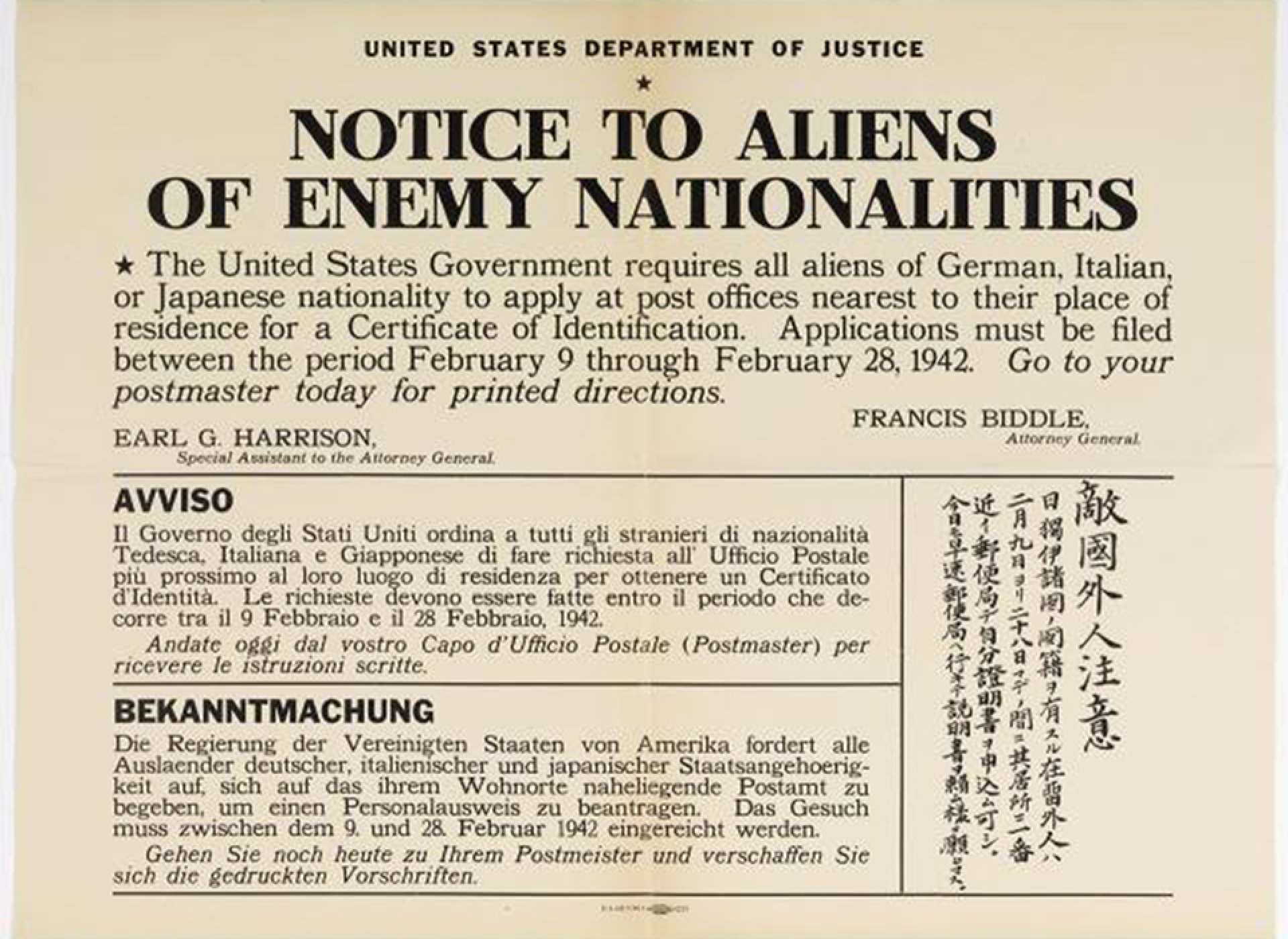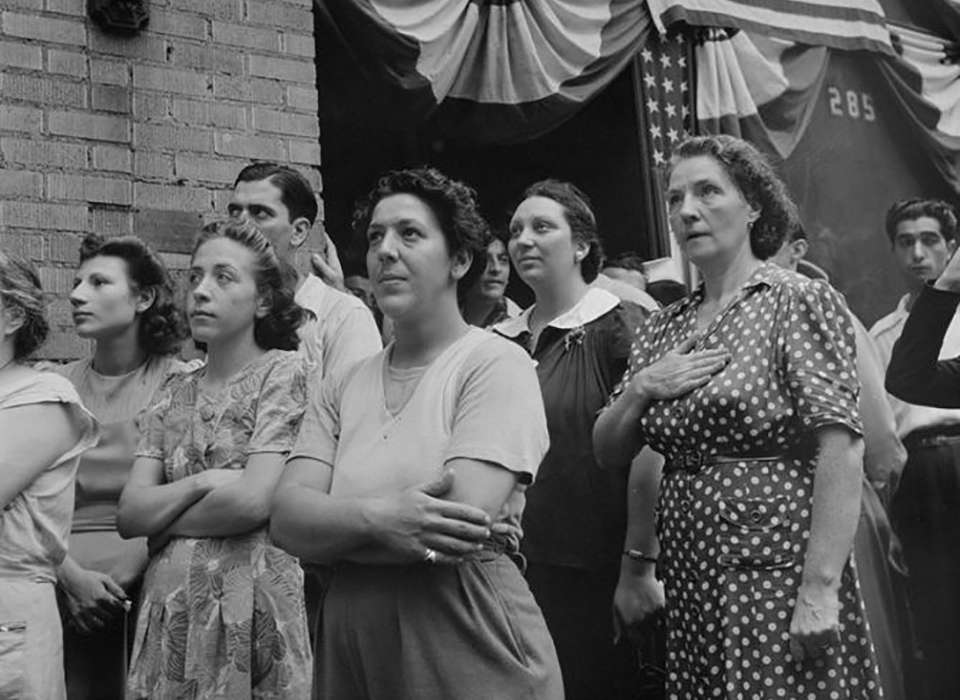Top Image: Italian Americans gather in a display of patriotism during WWII. Photo courtesy of the Library of Congress.
Hours after the attack on Pearl Harbor, Federal Bureau of Investigation agents in San Jose, California arrested Filippo Molinari, an Italian immigrant who sold subscriptions to L’Italia, a popular newspaper in his Italian American community. While held in custody, Molinari asked why he was being detained, only to be told that his arrest was “by order of the President.”
A few days later, FBI agents forced Molinari and approximately 500 other “enemy aliens”—including more Italian nationals as well as Japanese and German immigrants from California—onto a train bound for an internment center in Missoula, Montana. Later, Molinari recalled how cold his feet were when he got off of the train and stepped onto the freshly-fallen snow. He realized that he still wore his slippers and pajamas because he was unable to grab a coat or any heavy winter clothes before his arrest.
Across the country, FBI agents continued to arrest Italian immigrants during the days immediately following America’s declaration of war on Japan, Germany, and Italy. In New York City—where both foreign and American-born Italians made up approximately 18 percent of the city’s population—the Berizzi family witnessed an event like that of Molinari. Agents awoke Louis Berizzi, his wife, and their American-born children when they banged on the door of their apartment and entered to search the home for evidence of sabotage. Berizzi’s daughter, Lucetta, remembered how harrowing and confusing her father’s arrest was:
“We were all sound asleep. My father was in his pajamas; they told him to get dressed, as they had orders to take him away. No explanation was given…They [FBI agents] stayed in his bedroom while he dressed, so we had no time to speak to him privately. They did not even give him time to gather personal effects or toiletries. We were pretty shaken…Several days after his arrest, we learned that my father’s office at Rockefeller Plaza had been locked and sealed by the Enemy Alien Custodian, and all my father’s assets were blocked.”
The FBI, backed by President Franklin D. Roosevelt’s issuance of Proclamation 2527 on December 8, continued to arrest and take into “custody” (a broad term that could mean being held in long-term internment centers for enemy aliens, extended detention, and/or arrest and later release) Italian immigrants who were classified as enemy aliens (some who had existing files with the Department of Justice because of political activities or group associations declared dangerous by the FBI) and displayed some behavior that could be considered suspicious, subversive, and designed to undermine America’s safety and defense.
FBI agents confiscated property (including radios, weapons, and other materials that could lend themselves to conspiring against the United States) and arrested thousands of Italian immigrants—including Joe DiMaggio’s mother who lived in San Francisco, and famed NYC-based opera star Ezio Pinza. DiMaggio was able to coordinate his mother’s release and Pinza secured the help of Mayor Fiorello LaGuardia in requesting legal assistance. Others like Molinari and Berizzi, however, were not so lucky.
The wartime story of removal and detainment tends to focus on Japanese Americans forced from their homes along the West Coast in early 1942 and held in camps, but more than 600,000 Italian Americans experienced some form of restrictions placed on them because of their enemy alien status. Not all 600,000 were detained in internment camps (418 Italian immigrants were held in internment centers) as this number includes Italian American communities along the West Coast who were subject to curfews and often unfounded searches and seizures.
Still, the Department of Justice’s efforts to arrest foreign-born Italians with personal and familial ties to their homeland is an example of wartime fear and suspicion that greatly increased the surveillance powers of the federal government during World War II and resulted in hardship for Italian American families.
The story of Italian internment begins years before Pearl Harbor. Italians began to arrive in the United States in larger numbers beginning in the late nineteenth century through the early twentieth century because of political upheaval in their homeland and a demand for labor in America. By 1940, approximately 1,623,580 Italians had settled from coast to coast, in northern and southern communities, earning a living as manual laborers, shop owners, and fishermen.
San Francisco, New York, and Philadelphia were cities with large Italian American communities, but southern cities like New Orleans also witnessed a growing Italian American population through the early twentieth century. Prejudice and discrimination against working-class Italians were pervasive and the ethnic stereotypes of Italians as inherent criminals were widespread, but many Italians naturalized and their children became part of a broad, multi-ethnic New Deal coalition that supported President Roosevelt and his economic, social, and political programs during the 1930s. By the 1940s, Italian Americans—such as Fiorello LaGuardia—had secured political positions of power, but the rise of Benito Mussolini in Italy gave pause to the Department of Justice, the FBI, and President Roosevelt.
As tensions increased in the Pacific and Europe, FBI director J. Edgar Hoover directed agents to begin gathering data on immigrants from communist and fascist nations. At the time, Hoover focused on Japanese, Italians, and Germans. By 1939, his bureau had amassed an impressive database of foreign-born nationals who required extra surveillance for their activities (which ranged from political and union activism to subscribing to ethnic language newspapers) and, in the event of war, internment.
The lists became known as the ABC lists, with categories A, B, and C respectively characterized by high, moderate, and limited engagement with groups and organizations that could potentially double as subversive agencies. Beginning in the summer of 1941, the Immigration and Naturalization Service (part of the Department of Justice at the time) established procedures and centers in Montana, New Mexico, and North Dakota for interning enemy aliens should war occur.
The attack on Pearl Harbor triggered the implementation of the arrest and detention plans. On December 7, FDR issued Proclamation 2525, declaring all citizens of Japan ages 14 and older to be enemy aliens, making them subject to any regulations deemed appropriate by Attorney General FrancIs Biddle. The following day, FDR issued Proclamations 2526 and 2527, placing foreign-born Germans and Italians (respectively) within the same enemy alien category as foreign-born Japanese. Essentially, any individual from any enemy nation who had not initiated paperwork for naturalization was considered an enemy alien.

Notice from the Department of Justice declaring that all enemy aliens must register at their nearest post offices for a certificate of identification. Photo courtesy of the National Archives.
Though Executive Order 9066, signed by FDR on February 19, 1942, provided the Western Defense Commander, Lieutenant General John L. DeWitt, with the authority to declare areas of vulnerability along the West Coast and initiate procedures against enemy aliens there (specifically foreign and American-born Japanese), it was Proclamation 2527 that had the most impact on Italian immigrants living along the West Coast. The proclamation initiated searches and seizures by the FBI (no warrants were required and many were based on little proof of suspicious activity). Working closely with cultural associations or newspapers like Molinari, or, in the case of Lucetta Berizzi, frequent travels to and from Italy and speaking Italian raised red flags for the FBI.
Regardless of the suspicious activity (or lack thereof), any enemy alien detained in an Immigration and Naturalization Service center had the right to a hearing, overseen by a board of three civilians who would review evidence provided by the FBI and determine one of three rulings: immediate release, release on parole, or internment. According to official files and reports, the Department of Justice held 1,881 Italians in custody (later released) and interned 418 Italians.
While no American-born citizen of Japanese, Italian, or German descent fell under this enemy alien categorization, this did not prevent the FBI from arresting and even detaining naturalized citizens. In the spring of 1942, FBI agents searched the home of Pasquale DeCicco—a well-loved member of his community in New Haven, Connecticut—for evidence of conspiratorial activity with Italy.
DeCicco was a naturalized citizen of 30 years by that point and an active member of various cultural and ethnic associations. It’s unclear exactly what actions triggered someone in his home town to report him, but he was held in a detention center in Boston for three months before moved to a detention center on Ellis Island. After his time on Ellis Island, DeCicco moved to a detention facility in Fort Meade where he was interned for another year.
Beginning in early February of 1942, Italian immigrant communities faced a growing list of restrictions. The Department of Justice issued limits on travel for enemy aliens following Roosevelt’s January 14 Proclamation 2537, which required enemy aliens to register with the Department of Justice and carry paperwork with them at all times verifying their registration. Italians could only freely travel to and from work, places of worship, and medical care facilities.
Otherwise, they were required to fill out documents that listed their destination, mode of transportation, and return dates. This paperwork was filed with local US Attorney offices and forwarded to the FBI for their records. Attorney General Biddle also issued curfews for those enemy aliens living in certain communities along the West Coast, including major cities in California with large Italian American populations like San Francisco. Confiscation of property rounded out a series of violations that Italian immigrants faced in the early days of the war.
Early in the war, Italian immigrants living along the West Coast also faced the threat of mass removal. After General DeWitt declared Military Area 1 and 2 in the Western Defense Command as areas of exclusion for enemy aliens in March, he considered mass removal of Italian immigrants (along with German and Japanese nationals) from the West Coast. However, once his counterpart in the Eastern Defense Command, Lieutenant General Hugh Drum, decided that it was unnecessary (and logistically impossible) to remove enemy aliens in the East, the War Department advised DeWitt against initiating a similar course of action.
Instead, the War Department offered DeWitt the individual exclusion program which would allow individuals deemed suspicious to undergo removals and hearings. DeWitt would eventually remove 120,000 foreign and American-born Japanese, but beginning on February 24, 1942, he required nearly 10,000 Italian immigrants to move out of restricted areas of California along the coast (predominantly San Diego and San Francisco) to areas further inland. Sometimes, these distances were absurdly short—relocating a few streets over to move outside of restricted areas. In other cases, some went to the nearest large city closest to their homes outside of the restricted zones, like Reno, Nevada.
Regardless of the location, finding housing was often difficult, particularly when employment was interrupted. The Alien Property Division of the Department of Justice confiscated thousands of boats used by Italian fishermen along the coast, jeopardizing economic security and creating financial difficulties for their families. And, though not as harsh as removal or job loss, nearly 600,000 Italian Americans along the West Coast lived under curfews that restricted many activities for most of 1942.
On October 12, 1942—Columbus Day—Attorney General Biddle removed Italians from enemy alien status, lifting all restrictions, though there was still the possibility that individuals could be interned for suspicious activities. Despite restoration of certain rights and freedoms, the pain and memories of family disruptions, job loss, and internment remained with the Italian American community for decades to come.
But thanks to the work of historians such as Lawrence DiStasi who raised awareness of this una storia segreta (or secret history of internment) and the concern among American politicians post-September 11, 2001 that prejudice and discrimination could become issues again, the Department of Justice submitted a report to Congress on its own involvement in surveillance, civil rights violations, and internment, bringing to light the struggles of thousands of Italian Americans during World War II.
Stephanie Hinnershitz, PhD
Stephanie Hinnershitz is a historian of twentieth century US history with a focus on the Home Front and civil-military relations during World War II.
Cite this article:
MLA Citation:
APA Citation:
Chicago Style Citation:






![Max Fuchs, New York City cantor, sings as Rabbi Sydney [sic] Lefkowitz, Richmond, VA, conducts the first Jewish services from Germany.](/sites/default/files/styles/max_650x650/public/2025-10/image1.jpg)


